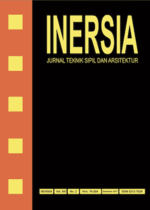Analisa Sebaran Banjir Akibat Keruntuhan Waduk Wadaslintang
DOI:
https://doi.org/10.21831/inersia.v17i2.30334Keywords:
Banjir, Debit Inflow, Keruntuhan BendunganAbstract
ABSTRACT
A heavy rain that happened in upstream area caused the increasing of debit inflow into the reservoir. If debit inflow got into the reservoir was big, so that, it caused the water overflowing from the top of reservoir. Thus, it caused the reservoir collapse that made a flood. The objective of this research was to know the map of flood spread when the reservoir was collapse and to know the flood speed and time towards the downstream. The method used is unit hirograf in having the calculation by HSS Nakayasu and the next was taken model by software HEC-RAS 5.06. From the result obtained the conclusion that breaking reservoir in QPMF. The result of flood hirograf data in dam break location using HEC-RAS application in HEC-RAS was the deepest flood in 8,1 m with the fastest maximum speed in 8,17 m/s, and the time needed by the flood to DAS Wawar, downstream area was for 0,78 hour.
ABSTRAK
Hujan yang terjadi pada daerah hulu dengan intensitas tinggi akan mengakibatkan peningkatan debit inflow yang masuk ke waduk. Apabila debit inflow yang masuk ke waduk besar maka dapat mengakibatkan meluapnya air melalui puncak bendungan. Hal ini dapat mengakibatkan terjadinya keruntuhan bendungan yang dapat menimbulkan bencana banjir. Tujuan penelitian ini adalah untuk mengetahui peta sebaran banjir saat bendungan runtuh dan mengetahui kecepatan dan waktu banjir tersebut mencapai ke daerah hilir. Metode yang digunakan adalah hirograf satuan dihitung dengan HSS Nakayasu dan selanjutnya dimodelkan menggunakan software HEC-RAS 5.06. Dari hasil penelitian diperoleh kesimpulan bahwa bendungan breaking pada saat QPMF. Hasil data hidrograf banjir pada lokasi dam break dengan aplikasi HEC-RAS pada saat QPMF adalah kedalaman banjir tertinggi sebesar 8,1 m dengan kecepatan maksimum tertinggi sebesar 8,17 m/dt., serta waktu yang dibutuhkan banjir untuk sampai ke daerah hilir DAS Wawar adalah selama 0,78 jam.
References
Balai Besar Wilayah Sungai Serayu Opak, Balai Besar Wilayah Sungai Serayu Opak Rekomendasi teknik. Yogyakarta, 2016.
Balai PSDA Bogowonto Luk Ulo, Balai PSDA Bogowonto Luk Ulo Rekomendasi teknik. Purworejo, 2016.
B. Triatmodjo, Hidrologi Terapan. Yogyakarta: Beta Offset, 2008.
Suripin, Sistem Drainase Perkotaan Yang Berkelanjutan. Jakarta: Andi Offset, 2004.
C. D. Soemarto, Hidrologi Teknik. Jakarta: Penerbit Erlangga, 1999.
M. Gee, Guidelines for Dam Breach Analysis. Colorando: , Department, Natural Resources Division of Water Resource, 2006.
G. . Brunner, HEC-RAS, River Analysis System Hydraulic Reference Manual. California: U,S, Army Corps of Engineers, Institute Ror Water Resources, Hydrologic Engineering Center, Davis, CA, USA, 2010.
Downloads
Published
How to Cite
Issue
Section
License
Authors who publish with INERSIA journal agree to the following terms:
- Authors retain copyright and grant the INERSIA journal right of first publication with the work simultaneously licensed under Creative Commons Attribution License (CC BY 4.0) that allows others to share the work with an acknowledgment of the work's authorship and initial publication in this journal.
- Authors can enter into separate, additional contractual arrangements for the non-exclusive distribution of the published version of the work (e.g., post it to an institutional repository or edit it in a book), with an acknowledgment of its initial publication in this journal.
- Authors are permitted and encouraged to post their work online (e.g., in institutional repositories or on their website) before and during the submission process, as it can lead to productive exchanges, as well as earlier and greater citation of published work.

INERSIA by https://journal.uny.ac.id/index.php/inersia was distributed under a Creative Commons Attribution 4.0 International License







